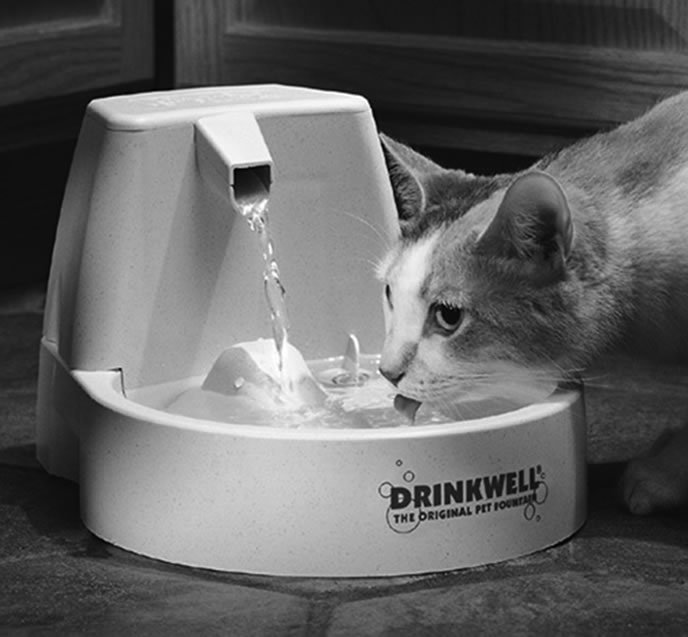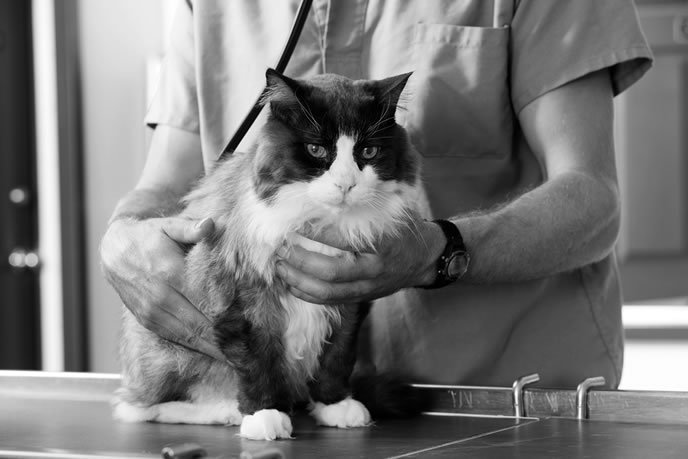Chronic kidney disease is common in older cats, with nearly a third of them over 12 affected and the prevalence increasing with age. The disease is incurable, involving the gradual loss of kidney function; however, owners can help slow its progression.
Studies show that therapeutic renal diets can lengthen patients’ lives compared to those fed adult maintenance diets. “Nutritional management is the cornerstone of treatment of CKD in dogs and cats,” says Meredith Miller, DVM, ACVIM, a lecturer in small animal medicine at Cornell University College of Veterinary
Medicine. “Clinical trials have shown that the diets improve quality of life and at least double the survival times for dogs and cats with CKD.”
Loss of Function. The challenge for owners is recognizing the warning signs of the disease — increased water consumption and urination — early on. By the time more dramatic signs, such as vomiting, lack of appetite, weight loss and lethargy are evident, loss of kidney function may already have begun. When indicators of CKD appear in urine tests, 66 percent of kidney function is already gone. When the most commonly used indicators in the blood become abnormal, about 75 percent of function is gone.
“The goal for owners is to change the cat’s diet when they first see signs of kidney disease,” says nutritionist Joseph Wakshlag DVM, Ph.D., at Cornell. “Whenever your cat is drinking and urinating more, see the veterinarian for blood work and a diagnosis.”
Two important caveats: Commercial senior diets are not the same as therapeutic diets and do not help manage CKD, says Dr. Wakshlag, president-elect of the American College of Veterinary Nutrition. And eating a renal diet will not prevent CKD. “There is no reason to start feeding a kidney diet just because a cat is older,” he says.
Therapeutic renal diets generally contain less protein, phosphorous and sodium than adult maintenance food. They are also more calorie-dense and contain more potassium, alkalizing agents, B-vitamins and omega-3 fatty acids. Some of the essential ingredients and their roles include:
Lowered protein at 26 percent, or so, reduces stress on the kidneys and limits the breakdown of protein in the bloodstream into toxins that make cats feel sick and lose appetite. The reduction requires a delicate balance, Dr. Wakshlag says. “You don’t want to restrict protein too much in cats because they have a higher protein requirement.” Inadequate protein can lead to skin and coat problems, muscle loss, impaired wound-healing and immune functions.
Lowered phosphorus in the food is directly correlated to an increased lifespan. High phosphorus concentration in the blood coupled with calcium loss increases the release of the parathyroid hormone that contributes to calcium and phosphorus leaching from bones. Excess phosphorus and calcium also collect in tissues, causing mineralization of the kidneys and other organs, with toxic effects.
Additional potassium. “Potassium is an electrolyte that helps cells function properly,” Dr. Wakshlag says.
Reduced dietary sodium helps prevent hypertension (high blood pressure).
Alkalizing agents avoid a buildup of acid, which can tax kidney function.
Omega-3 fatty acids and B vitamins may help maintain heart health.

Cats on a renal diet must eat adequate amounts to get the benefits of each nutrient, Dr. Wakshlag says. “Cats are more finicky, and we tend to have more problems with them eating.” He recommends that owners discuss increasing their cat’s appetite with a nutritionist through homemade diets or making food more palatable by warming or adding flavorings. Appetite-enhancing drugs include cyproheptadine and mirtazapine, which has been shown to increase weight in cats with CKD in a study at Colorado State.
Veterinarians diagnose CKD with blood tests and urinalysis. The tests can reveal elevated phosphorus, high levels of creatinine, a by-product of muscle metabolism excreted by the kidneys, and the amount of blood urea nitrogen that comes from the waste product urea.
They assess CKD’s severity using staging guidelines, ranging from mild stage one, when cats may not show signs, to severe stage four, when 90 percent of kidney function is lost.
Gauging Prognosis. “The stage of the disease gives the most information about prognosis,” says Dr. Miller. “The higher the stage, the shorter the survival time. I see severe CKD as a cause of death in both cats and dogs, but cats often have stable CKD for months to even years before the disease progresses to severe. I’ve managed some cats with a good quality of life for over four years.”

Treatment can be complicated by common co-diseases, including anemia, hyperthyroidism, hypertension and heart disease, and underlying problems such as urinary infections.
CKD is managed with supportive care, including potassium supplements, anti-nausea drugs, acid reducers, fluid therapy and feeding tubes. Increasing fluids offsets dehydration and helps impaired kidneys concentrate urine. Subcutaneous fluid injections help, as does feeding canned food, supplying fresh water, adding water bowls or fountains and flavoring water with low-or-no-salt broth.
Some veterinary hospitals around the country offer hemodialysis and kidney transplants, but they’re rarely used for feline CKD because of the cost, the limited number of centers and stringent qualifications.
In part because older cats frequently develop CKD, the American Association of Feline Practitioners and the American Animal Hospital Association advise that cats 10 years of age and older have twice-a-year veterinary exams, including blood and urine testing.
In addition, Dr. Miller says she can’t stress the importance of owners of pets with CKD scheduling routine follow-up exams enough. “Most pets with mild CKD can be checked every four to six months, but if they have severe CKD, they should be seen every two to three months.”
Diligent follow-up can help identify emerging complications of kidney disease that are better treated before they make cats feel sick, Dr. Miller says. “Developing a strong partnership with a veterinarian can help you make the best decisions to keep your cat feeling well with CKD for as long as possible.”

